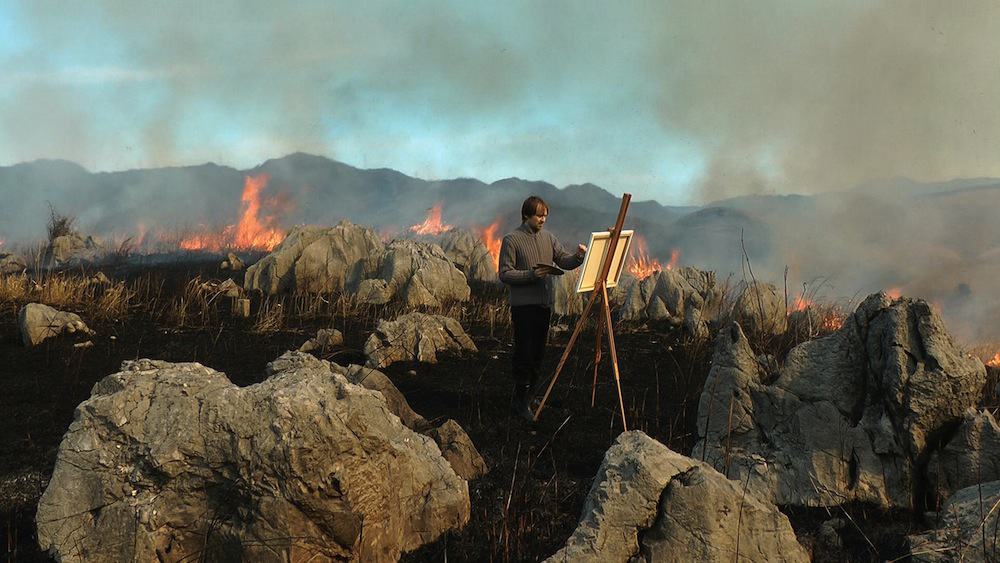
Wojciech Gilewicz, Painter’s Painting, 2016 (on-going project), video stills, video 18 min
The Painter’s Painting?
Is this the Platonic Painter that all painters aspire to emulate?
Is this the one painter that this painter (Wojciech Gilewicz) embodies?
Is this his, Wojciech Gilewicz’s, attempt to embody Everyman (the Painter)?
Or to efface himself?
And ‘Painting’?
Is that the action of putting paint on a canvas?
Or the resulting artifact?
Or the sum total of the paintings the painter paints?
For ‘Painter’, read ‘Artist’. For ‘Artist’, Read ‘Human’.
Or is Gilewicz both subject and object?
Subject, medium, and object.
In the last days of May 2016 we met up outside the Cuchifritos Gallery with Wojciech Gilewicz, and Bartek Remisko – the curator of the artist’s most recent solo show, “Cuboids” – inside the Essex Street Market in the Lower East Side of Manhattan. It took us three hours to travel down from upstate New York. But it took Wojciech and Bartek nearly half that time to travel in by the A train from the Rockaways in the Far East of Queens.
(By the way, Gilewicz’s solo show held in Spring 2015 in the prestigious Foksal Gallery in Warsaw was actually titled “Rockaway”1 ) The notion of New York City being one single place, a single point in space, neglects the whole physical reality of travel. The getting there, being in a bubble, a half-world or zone of uncertainty between tension and boredom, being in a hurry and standing still, whether in a stifling subway carriage or a traffic jam on the FDR East River Drive. Appropriately enough…
Though a painter by training and vocation, Wojciech’s most recent works are video pieces which deal with identity, place, gesture and that peculiarity of travel where the in-between spaces take on their own significant, dominating and particular flavour. The work interrogates this reality. And painting.
WG: “I think that reality (the term itself sounds a little philosophical, or maybe broad, but I like this word because it is ‘normal’) is what we should all care about. Not a simulacrum of reality in the form of art. (Here I wanted to say that we derive greater pleasure from looking at a flower than from looking at a flower in a picture, but I hesitated, because even such simple statements cause far too many problems — well, because, what flower? which artist? What painting? What was the reason/impulse to create this painting? and so on… So we could simplify by stating that art, even this abstract art, always in some sense remains in some relation to reality).”
In unsignalled straight montage, in long static takes, we shift from one anonymous (Asian?) mall, streetcorner, airport or escalator to another. Anodyne, faceless, deracinated slices of idealised eastern-western cityscapes and their peripheries.
Here stands a painter’s easel (unless it’s THE Painter’s easel…), its back facing us, the viewers, the camera, the painter’s eye.
And here is Wojciech Gilewicz himself, discreet, brush in hand, palette grasped in the iconic gesture of The Painter. While all around, people go about their business, behind the painter’s back. The painter concentrates, measures, darts swift strokes (unseen) onto the canvas, paints, looking blankly out not quite in our direction, not quite making eye contact with us. He’s looking beyond us, over behind our shoulder, at the subject of his painting. He works very rapidly.
This sovereign gesture of The Painter is not a new trope – Velasquez used it in his “Meninas”. His real subject was us, the onlookers. Or himself, seen reflected in our gaze.
These works, incidentally, took a period of six years to make, as they were shot only when Gilewicz was travelling on other legitimate business trips as a painter – to his openings and exhibitions in foreign countries, usually on a tight budget, often for very short periods in that internationalized world of the hotel, public transport systems, the interior of jetplanes, and those other dreamlike zones which Gilewicz examines in his work. The painter was also – significantly – always alone. There was no video crew or team of assistants shooting the work or preventing (or causing…) potential incidents with the unaware public. He would simply set up his easel and camera, and begin filming and painting.
We noticed that Gilewicz, though not wearing any kind of uniform, is always attired in similar shades of grey. Asked if this was an attempt at a neutral camouflage, or whether he had some other reasons, he replied:
WG: “Of course, not drawing attention to myself is one reason for the grey. But I also consider that tone of grey to be highly representative of the painter, as if you took every single colour and mixed them up (including white), that’s the colour you would end up with.”
As some of the scenes in the video seem to be shot in Korea, we wondered whether there was any connection to the colour of choice for Korean Zen monks’ robes (this same grey, as opposed to say, a charcoal black in Japan):
WG: “Yes. As a matter of fact, when I was in Seoul, I noticed a shop full of clothing in just this tone, which I am very attracted to. When I went into the shop to examine the clothes, I found it was the place where monks buy their robes.”
Then, suddenly, a cut: we are somewhere else. A new continent. A new night. Wojciech painting another same image. Us, Beyond, Offscreen, but using the same easel. Each new place, one shot. Cut. New place.Do we notice the banality of the locale? Or when we segue into a new empty space in the videowork from 2010, “Visitor”? (Co-incidentally (?) this was also the title of the fictitious musical LP which David Bowie’s alien character Thomas Jerome Newton ‘produced’ in the film “The Man Who Fell To Earth”.) The easel in this work has now disappeared. The Painter remains, now the subject of his own camera’s gaze.

Wojciech Gilewicz, Visitor, 2010, video still, video 10 min
But here, he’s blending in, or trying to. Not pigments on a palette, but himself, his body and meagre traveller’s belongings in these liminal and strangely clean and empty places – stairwells, the walls and doorways of luxury stores at night.
Gilewicz is performing minimal actions, repetitions, really not doing anything, doing nothing. Or to re-parse that phrase – performing nothing. Little loops of gesture. Is he about to make his bed here, in a cardboard box? And this Asian gentleman (Korean? Japanese? Chinese?) seems to be doing the same, a ballet with card. Their gestures mirror. And here, another old man is having difficulty climbing a marble staircase in a pedestrian underpass. By his side, present yet seemingly invisible, Wojciech makes the same hesitant shuffle. Same pauses. The same turn, same struggle to put one foot on the next highest step. Then as the man slowly notices the stranger at his side, Gilewicz slowly turns and descends the step, not acknowledging his sudden visibility. He unrolls his sleeping bag. Neon lights, their shadows. People in the shadows, mirror shadows, shuffling. The tension between the innocent, the familiar and the off-, the eerie. Like a shaman mimicking the shuffle of the buffalo, the better to hobble its gait. The risk being that the shaman will get hobbled himself, by the bison. The dangerous magic of mirroring. Who is the reflection? What are we watching? Who are we, the watchers. The subject leaves the frame. What now? His eye remains. Cut.
WG: “Reality often seems uninteresting so people try to beautify it, bend it, manipulate, interpret… In my view it should be the other way round. Therefore I am very interested in what I call the ‘zero’ situation: when we do not process reality, we do not fabricate its image, but we take it in ‘as is’.”
What is it to travel? To go from A to B? And what of those interstitial zones which are the same everywhere. Designed to be the same in every transitional passage, border, airport gate, waiting room, rest stop, train station, cloned mall, underpass, well-lit doorway at night.
WG: “The effect of the cutting between these very different places and scenes is that while some will seem commonplace to us, others will seem exotic. Yet as the work travels, what is commonplace and what is exotic will change, according to the location of the exhibition and the background of the audience. This shifting of any particular scene from normal to exotic and back again is very intriguing to me.”
And if you stay in these zones, who else is there? And how to interact? This is the modern limbo.
And who is going, who coming, and who returning home?
Home. It is not ‘abroad’ which is the opposite of ‘home’. ‘Abroad’ is, or could be, ‘other’. The opposite of home is the interstitial. Not quite clean, the Americans have a legal term for it: broom-clean, pure function, empty of natives. These zones grow apace, as their temporal corollary grows: delays, postponements, time zone fatigue, security check buffers, well-appointed but closed food courts, transit rides to the destination cities that do not run until 6 a.m. Travellers with all their temporarily necessary objects in black shell-cases on rollers. The sound of small wheels on ridged or stippled rubber. The sudden change in tone as they glide over concrete floors. Automatic trains. Night. It’s cheaper at night. The wait is longer. The automatic loops of sprites in the backgrounds of video games. Walking in circles, bumping into the furniture, too rigid and deliberately made uncomfortable so you cannot sleep on it, gesturing in circles, thinking in circles…
This work is now presented as part of the “The Travellers” exhibition at the Zacheta – National Gallery of Art in Warsaw curated by Magdalena Moskalewicz (on view from May 14th to August 21st, 2016) as Gilewicz comes back to Poland, but without ‘returning’. Comes from America, yet without having become fully ‘American’ (which America?). Condemned, by choice and circumstance to that interstitial limbo of visas, Green Cards, Nationalities, Passports, immigration lines. Not a refugee, but neither having a refuge, not seeking refuge.
This back-and-forth brings to mind the endless instances of copying, whether in video, sound, Xerox or the shared gestures and verbal tics across an open culture (open as a can may be opened…) which is now worldwide. Seoul, a copy of New York. Berlin, a copy of Tokyo. Shanghai, a copy of London. All of them variant copies of Heathrow, Schiphol, Okęcie, JFK.
The digital and the electronic have only accelerated these processes, but they have been present and latent with their reflexivity and power to mutate and assimilate throughout human history: Man is a copying animal.
WG: “Perhaps the humor in my work is a disguise for the absurd and the destructions of realism. As I mentioned, however, there is a small issue: I am an artist and artists must produce artifacts. When an artist fails to do so, no one knows about them & their work. In consequence they fall out of the art market, no one wants to deal with an artist who doesn’t produce. Well, of course, such an artist also can’t support himself. 🙂 Or maybe this humor/irony is only a cover-up for the destruction of art?”
It also seems to us that these new video works continue a line, rigorously pursued for at least the past decade, back to his meticulously painted and repainted objects in his “Cuboids” (2015) and the video thereof presented in June 2016 in the framework of Currents New Media Festival in Santa Fe, New Mexico in the US.; and the strictly literal mimicry and disguising of buildings and sections of urban space which Gilewicz replaced or – better – repaired, with hyperrealist or disguised paintings, and ‘hid’ in plain sight on the city streets in his earlier series “Revitalisations”(2007). These perfect mimics of so-called reality then became transformed into abstract paintings when removed from the streets and placed ‘on display’ in a gallery situation.
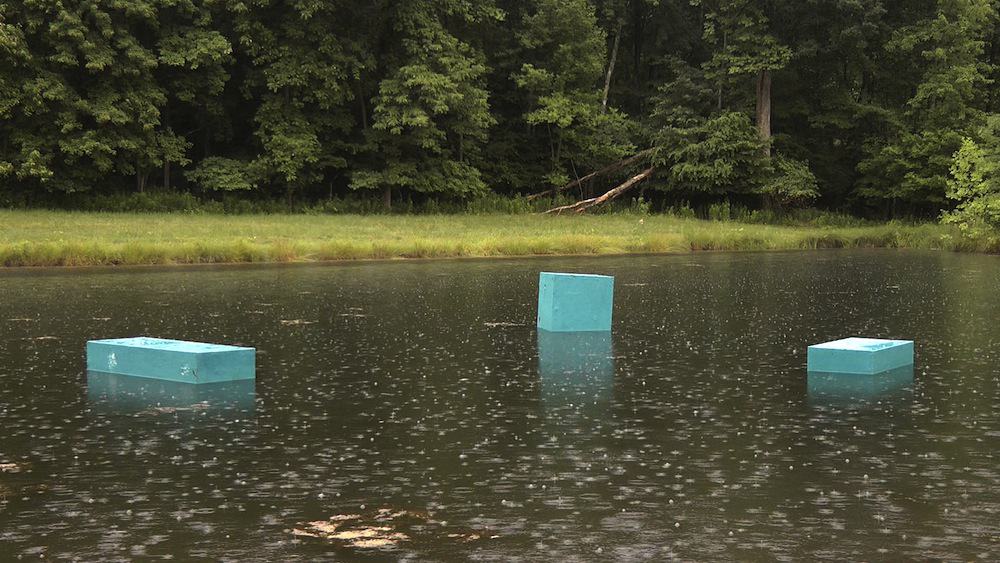
Wojciech Gilewicz, Cuboids, 2015, video stills, video 15 min
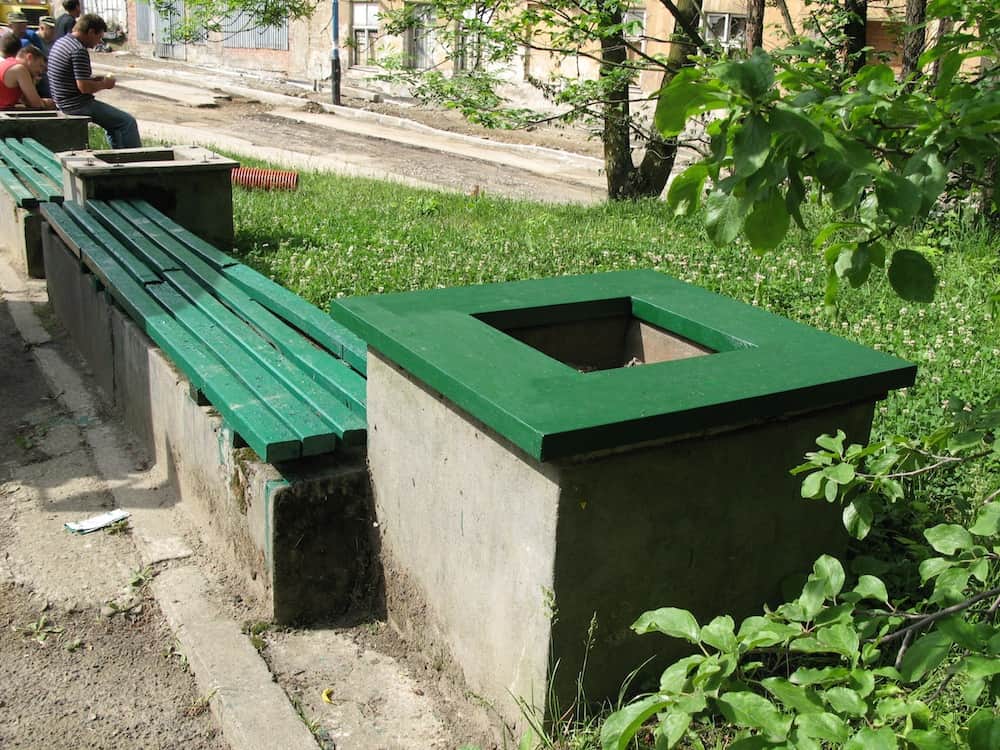
Wojciech Gilewicz, Revitalizations, 2007, oil on canvas, 29” x 29”, The missing cover of a flower stand was replaced with my painting.
We asked Gilewicz if he thought that all these mimetic behaviors, camouflages, imitations and so forth could have something to do with his drive to assimilate when he landed in the US as a young adult? An attempt to fit in? Many fresh immigrants feel the unsettling pressures of the new environment…
“It’s a good question and I don’t really know the answer. But the truth is that I feel pretty good, or happy, wherever I go.”
From canvas to object to place to person, has Wojciech Gilewicz now become his own cuboid? The Painter’s Painting?
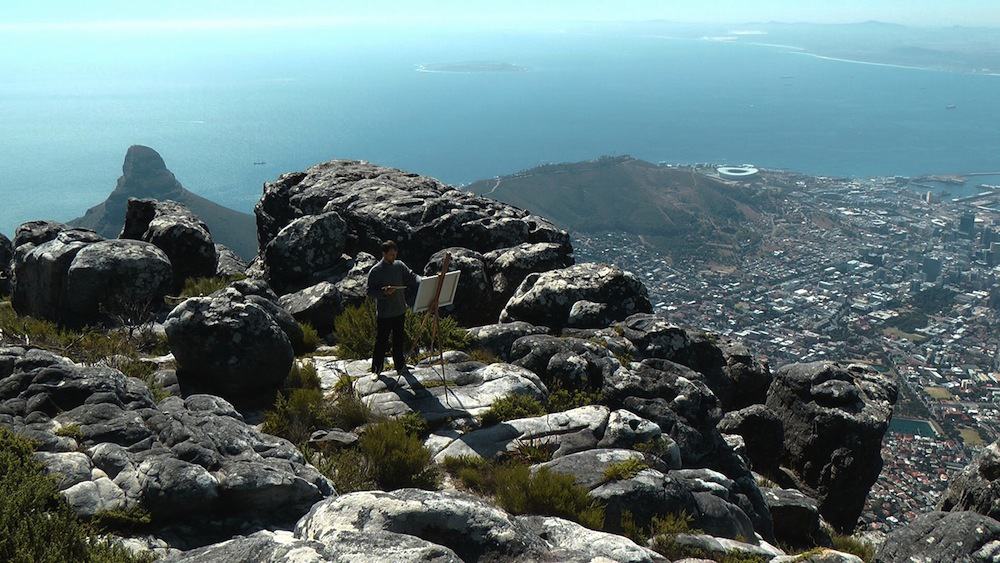
Wojciech Gilewicz, Painter’s Painting, 2016 (on-going project), video stills, video 18 min
1 The catalogue to the exhibition „Cuboids E22 Rockaway” presented at Galeria Foksal / Cuchifritos Gallery, with texts by the independent film critic Ela Bittencourt (São Paulo), Sara Reisman from the Shelly and Donald Rubin Foundation (New York), and Todd Shalom of Elastic City (New York), with and introduction by the independent scholar David A. Goldfarb (Honolulu) can be found here.
words by Dorota Czerner & Russell Richardson
Biography:
Wojciech Gilewicz was born in 1974 in Biłgoraj, Poland. He lives and works between New York and Warsaw. He is a painter, photographer and author of installations, performative actions and videos. Drawing on his experience of the painting medium, he creates formally varied works, which seek to investigate the boundaries of art and space. Read more: www.gilewicz.net

Wojciech Gilewicz, Revitalizations, 2009, oil on canvas, 29” x 29”, In the center of this photo a painting from the previous image installed in the white cube of the gallery.

Wojciech Gilewicz, Painter’s Painting, 2016 (on-going project), video stills, video 18 min
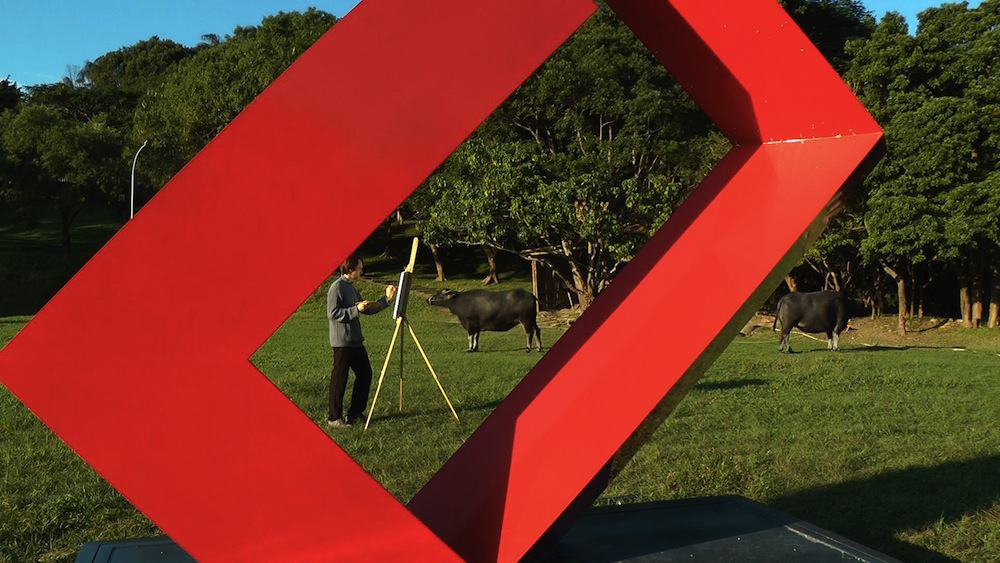
Wojciech Gilewicz, Painter’s Painting, 2016 (on-going project), video stills, video 18 min
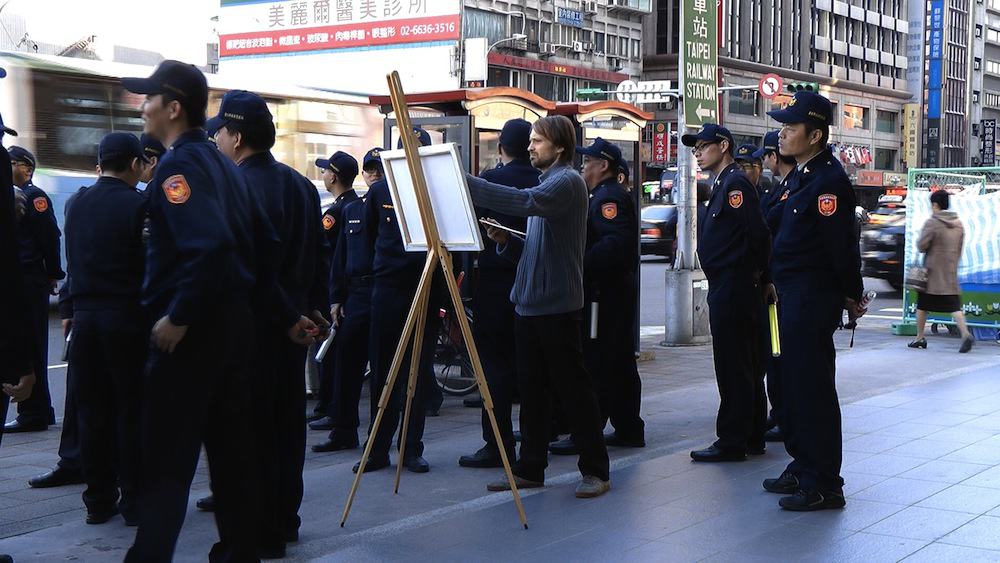
Wojciech Gilewicz, Painter’s Painting, 2016 (on-going project), video stills, video 18 min
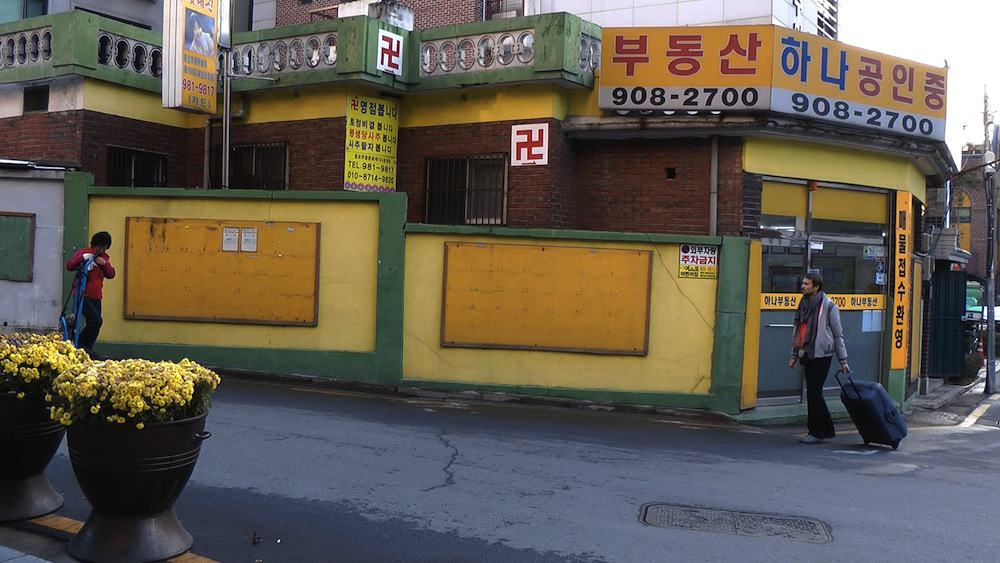
Wojciech Gilewicz, Rockaway, 2014, , video stills, video 17 min

Wojciech Gilewicz, Painter’s Painting, 2016 (on-going project), video stills, video 18 min
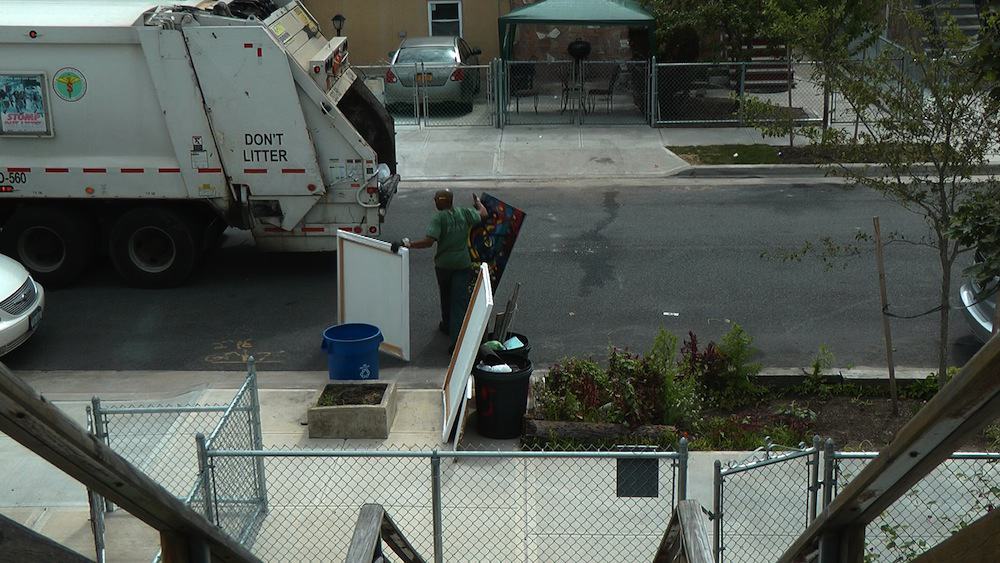
Wojciech Gilewicz, Rockaway, 2014, , video stills, video 17 min







